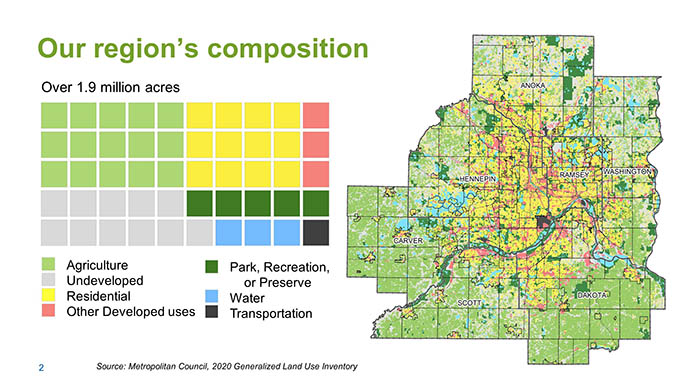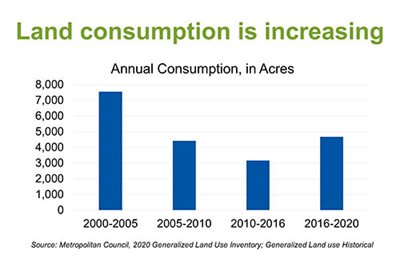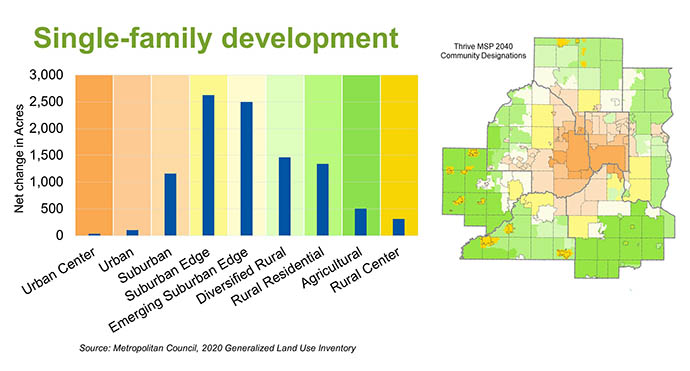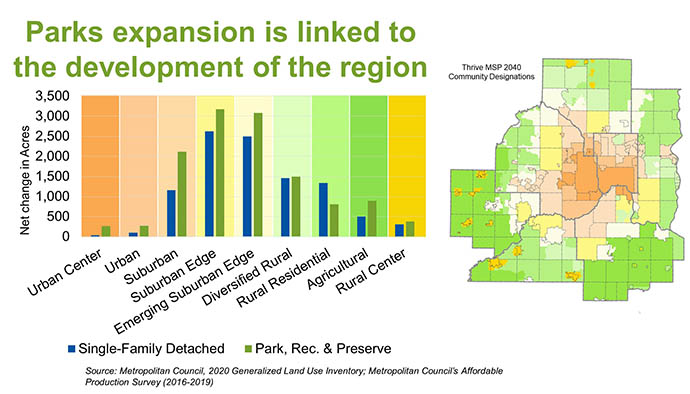Of the 1.9 million acres in the seven-county metro area, just over half the region’s acres are agricultural or undeveloped. Residential development, mostly single-family homes, occupies about 25% of the region’s acres. Parks, recreation, and preserves account for 10% of the region’s land use.
Solar farms are a newer industrial land use. Of the region’s acres that are considered “industrial,” solar farming constitutes 7% of those and 75% of all new industrial development. The amount of land devoted to parks, of all kinds, has grown, while acres for golf courses continues to decline.
These are among the findings of the Met Council’s 2020 Generalized Land Use Inventory, conducted about every five years since the 1970s. We use aerial photography, county and assessor information, building permits, and internet searches to collect the information.
Development has become more compact in recent period
“The inventory shows existing land uses and is a snapshot in time,” said Paul Hanson, a staff geographic information system specialist. “We use it to identify land use trends, assist in forecasting and land supply analyses, and enhance planning initiatives.”
 Among the trends that Hanson says stand out:
Among the trends that Hanson says stand out:
- Land consumption in the region has increased for the first time since 2005.
- Development is more compact. Despite the increase in land consumption, the region is using less land to accommodate the same number of people and households.
- Single-family detached housing (not connected to other housing units) is the main driver of land consumption in the region.
- As the region grows in population and households, so does the number of acres committed to parks.
“Housing is the #1 consumer of land,” said Hanson. “It constitutes nearly two-thirds of all developed land in the region.”
Single-family housing development occurring on suburban edge
Hanson said most single-family housing development is occurring in suburban areas, in communities that are planning for growth and have available land. He said multi-family and mixed-use development is spread across the developed part of the region but is occurring primarily in suburban areas of the metro area.

Parks expansion occurs with single-family development
“We love our parks,” said Hanson. “Interestingly, parks expansion is occurring hand in hand with single-family housing development. New neighborhoods tap into agricultural and undeveloped land but include new parks and recreational amenities as we grow as a region. In the last four years, we’ve added more than 10,000 acres of park land.”

“Green space, or areas covered in plant life, is something we value as a region,” said Ellen Esch, senior data scientist. “We rely on green spaces for recreational activities and solace, but they also provide critical ecosystem services we might not consciously think about.
“Green spaces clean our air, regulate climate, reduce erosion and runoff, and provide nourishment for animals and insects,” she said.
“As a region, we must never lose sight of the benefits we enjoy from our natural environment as we make land use decisions and considerations.”
Listen to the land use presentations
To review recorded presentations on Land Use and Green Spaces, see the Council Committee of the Whole meeting on August 4, 2021.